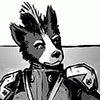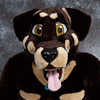Anthropomorphic animals or zoomorphic humans?
14 years ago
General
The furry fandom is frequently characterized as being about "anthropomorphic animals" -- being from the greek "anthropos" meaning "human" and "-morphic" meaning "having the form of" -- that is to say, it is about animals that have the form of humans (or some other human aspects.)
The more I think about this, the more I think that this definition is backwards. It is not about animals that have human characteristics -- it is about humans that have animal characteristics, that is to say, zoomorphic humans ("zoo" meaning "animal".) I posit that we are not really interested in animals that appear in some way human (walk on two legs, speak, ...), but that we are rather interested in humans that appear in some way like animals (have fur, walk on four legs, ...)
Let's take one of the earliest examples of "furry" -- Aesop's fables, for example The Fox and the Crow. The fable is not really about a fox, or about a crow, or any two animals having taken on human characteristics. The fox and the crow are humans, in essence -- one human who is susceptible to flattery, and another who is cunning and willing to use flattery to achieve their goals. Aesop puts them in the guise of animals for the sake of the story, but their essence remains human, not animal.
Another frequent example is egyptian gods -- gods like Bastet and Anubis that appear with animal heads. By the time of the egyptians, we were well on the way of replacing true animal gods (the way they are often found in "primitive" cultures) with gods made in our own image (and indeed by the time of the ancient greek we'd already populated the whole pantheon with entirely human gods.) We were not at the mercy of the animals of the forest anymore and did not need to idolize them anymore, and instead idolized the new masters of nature, ie. ourselves. Bastet and Anubis are holdovers from an earlier time, not true animal gods that have taken on a human form, but rather human gods with animal aspects.
Let's turn to something more recent. Is Mickey Mouse a mouse? I don't think so. Mickey Mouse is a little human -- a human with big round ears and a big nose, but still in essence a human. This is illustrated by the fact that Mickey Mouse has a pet dog -- Pluto -- but also an anthropomorphic dog friend -- Goofy. One is a pet and the other is a friend because they are different in essence -- Pluto is an animal in essence, whereas Goofy is a zoomorphic human. There is a divide between humans (even zoomorphic ones) and animals that cannot be crossed.
Therianthropy is another example of zoomorphism -- it is literally about a human taking on the shape of an animal (and losing some human characteristics in the process.) A werewolf does not start out as a wolf and takes on human form. He starts out in human form and takes on an animal shape. Describing werewolves as "anthropomorphic" is quite literally backwards.
It is probably too late now to rename ourselves to "zoomorphic fandom", but the difference between anthropomorphism and zoomorphism still bears thinking about. Are we interested in the animal essence, or the human essence?
The more I think about this, the more I think that this definition is backwards. It is not about animals that have human characteristics -- it is about humans that have animal characteristics, that is to say, zoomorphic humans ("zoo" meaning "animal".) I posit that we are not really interested in animals that appear in some way human (walk on two legs, speak, ...), but that we are rather interested in humans that appear in some way like animals (have fur, walk on four legs, ...)
Let's take one of the earliest examples of "furry" -- Aesop's fables, for example The Fox and the Crow. The fable is not really about a fox, or about a crow, or any two animals having taken on human characteristics. The fox and the crow are humans, in essence -- one human who is susceptible to flattery, and another who is cunning and willing to use flattery to achieve their goals. Aesop puts them in the guise of animals for the sake of the story, but their essence remains human, not animal.
Another frequent example is egyptian gods -- gods like Bastet and Anubis that appear with animal heads. By the time of the egyptians, we were well on the way of replacing true animal gods (the way they are often found in "primitive" cultures) with gods made in our own image (and indeed by the time of the ancient greek we'd already populated the whole pantheon with entirely human gods.) We were not at the mercy of the animals of the forest anymore and did not need to idolize them anymore, and instead idolized the new masters of nature, ie. ourselves. Bastet and Anubis are holdovers from an earlier time, not true animal gods that have taken on a human form, but rather human gods with animal aspects.
Let's turn to something more recent. Is Mickey Mouse a mouse? I don't think so. Mickey Mouse is a little human -- a human with big round ears and a big nose, but still in essence a human. This is illustrated by the fact that Mickey Mouse has a pet dog -- Pluto -- but also an anthropomorphic dog friend -- Goofy. One is a pet and the other is a friend because they are different in essence -- Pluto is an animal in essence, whereas Goofy is a zoomorphic human. There is a divide between humans (even zoomorphic ones) and animals that cannot be crossed.
Therianthropy is another example of zoomorphism -- it is literally about a human taking on the shape of an animal (and losing some human characteristics in the process.) A werewolf does not start out as a wolf and takes on human form. He starts out in human form and takes on an animal shape. Describing werewolves as "anthropomorphic" is quite literally backwards.
It is probably too late now to rename ourselves to "zoomorphic fandom", but the difference between anthropomorphism and zoomorphism still bears thinking about. Are we interested in the animal essence, or the human essence?

wruf
~wruf
You know I think you're absolutely right with this. The furry fandom is full of misnomers though and trying to put it right is like trying to turn back the sea. I get annoyed every time someone uses the word lapine (the bunny language from Watership Down) instead of leporine (the word to describe an animal from the Leporidae family) for rabbit/hare-like but I'm not even going to try to correct people on it. I just treat it as a weird furry word.

FelixKatz
~felixkatz
OP
I just say "lagomorph" but I guess I got that from Sam&Max ;)

leinir
~leinir
Spot on. Well thought there :)

 FA+
FA+